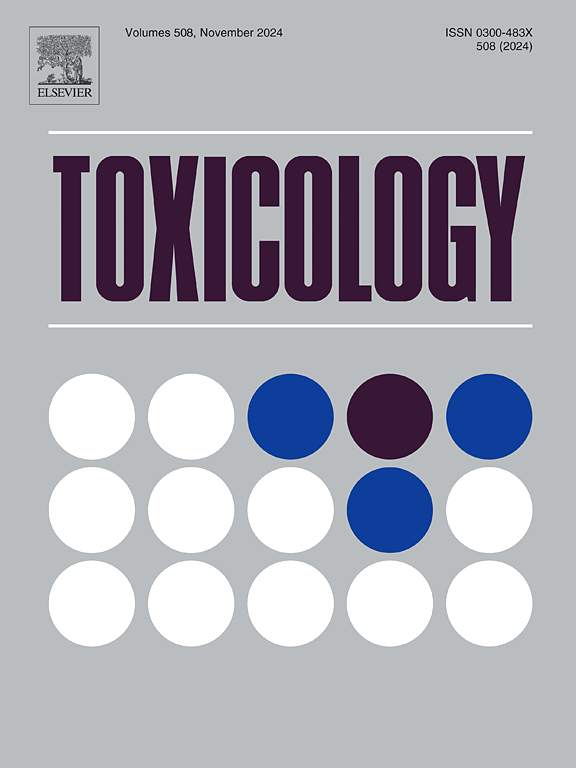纳米塑料通过抑制PPARγ破坏肝脏脂质代谢:一项基于消化系统暴露的研究。
IF 4.6
3区 医学
Q1 PHARMACOLOGY & PHARMACY
引用次数: 0
摘要
纳米塑料(NPs)是一种新兴的环境污染物,能够跨越生物屏障并在肝脏等器官中积累,人们越来越关注其对非酒精性脂肪性肝病(NAFLD)的潜在影响。值得注意的是,瓶装水已被认为是每日接触NP的主要来源。然而,NP暴露与NAFLD发病之间的关系以及机制基础仍不清楚。为了研究这一点,我们分析了NHANES 2013-2016周期的数据,使用每日瓶装水摄入量来估计NP暴露,并使用肝脂肪变性指数(HSI)作为肝脏脂肪积累的指标。通过动物和细胞实验来评价np诱导的肝脏改变。此外,对肝脏组织进行转录组学分析,并与DisGeNET和比较毒物基因组学数据库(CTD)相结合,实现了生物信息学分析和关键调控途径的鉴定。流行病学结果显示瓶装水消费量与HSI之间存在显著正相关。实验结果表明,在体内和体外模型中,NP暴露诱导肝脏空泡化、氧化损伤、代谢紊乱和炎症。转录组学和数据库整合显示,NP暴露抑制PPAR信号通路,特别是通过下调PPARγ表达,过量的ROS生成可能有助于这种抑制。这些结果在不良结果通路(AOP)框架中进行了总结,说明NP暴露如何损害PPARγ信号并促进肝脂质积累。总之,本研究提供了环境NP暴露可能是NAFLD发展的一个促成因素的证据,并强调了从瓶装水中摄入NP的潜在公共卫生影响。本文章由计算机程序翻译,如有差异,请以英文原文为准。
Nanoplastics disrupt hepatic lipid metabolism via the inhibition of PPARγ: a study based on digestive system exposure
Nanoplastics (NPs) are emerging environmental contaminants capable of crossing biological barriers and accumulating in organs such as the liver, raising growing concerns about their potential contribution to nonalcoholic fatty liver disease (NAFLD). Notably, bottled water has been recognised as a major daily source of NP exposure. However, the associations between NP exposure and NAFLD onset, as well as the mechanistic basis, remain unclear. To investigate this, we analysed data from the National Health and Nutrition Examination Survey (NHANES) 2013–2016 cycles, using daily bottled water intake to estimate NP exposure and the hepatic steatosis index (HSI) as an indicator of liver fat accumulation. Animal and cellular experiments were conducted to evaluate NP-induced hepatic alterations. Additionally, transcriptomic analysis of liver tissues was performed, and integration with DisGeNET and the Comparative Toxicogenomics Database (CTD) enabled bioinformatic analyses and identification of key regulatory pathways. Epidemiological results revealed a significant positive correlation between bottled water consumption and HSI. Experimental findings demonstrated that NP exposure induced liver vacuolisation, oxidative damage, metabolic disruption, and inflammation in both in vivo and in vitro models. Transcriptomic and database integration revealed that NP exposure suppressed the PPAR signalling pathway, particularly by downregulating PPARγ expression, with excessive ROS generation likely contributing to this inhibition. These results were summarised in an adverse outcome pathway (AOP) framework, illustrating how NP exposure may impair PPARγ signalling and promote hepatic lipid accumulation. In conclusion, this study provides evidence that environmental NP exposure may be a contributing factor to NAFLD development and highlights the potential public health impact of the intake of NPs from bottled water.
求助全文
通过发布文献求助,成功后即可免费获取论文全文。
去求助
来源期刊

Toxicology
医学-毒理学
CiteScore
7.80
自引率
4.40%
发文量
222
审稿时长
23 days
期刊介绍:
Toxicology is an international, peer-reviewed journal that publishes only the highest quality original scientific research and critical reviews describing hypothesis-based investigations into mechanisms of toxicity associated with exposures to xenobiotic chemicals, particularly as it relates to human health. In this respect "mechanisms" is defined on both the macro (e.g. physiological, biological, kinetic, species, sex, etc.) and molecular (genomic, transcriptomic, metabolic, etc.) scale. Emphasis is placed on findings that identify novel hazards and that can be extrapolated to exposures and mechanisms that are relevant to estimating human risk. Toxicology also publishes brief communications, personal commentaries and opinion articles, as well as concise expert reviews on contemporary topics. All research and review articles published in Toxicology are subject to rigorous peer review. Authors are asked to contact the Editor-in-Chief prior to submitting review articles or commentaries for consideration for publication in Toxicology.
 求助内容:
求助内容: 应助结果提醒方式:
应助结果提醒方式:


